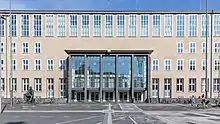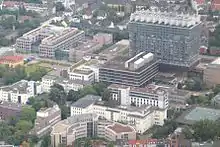University of Cologne
The University of Cologne (German: Universität zu Köln) is a university in Cologne, Germany. It was the sixth university to be established in Central Europe[2] and, although it closed in 1798 before being re-established in 1919, it is now one of the largest universities in Germany with more than 48,000 students. The University of Cologne is a German Excellence University.
Universität zu Köln | |
.svg.png.webp) University seal of 1392 | |
| Latin: Universitas Coloniensis | |
| Type | Public |
|---|---|
| Established | 1388 |
| Budget | €725.2 million[1] |
| Rector | Axel Freimuth |
Academic staff | 7,393[1] |
| Students | 48,962[1] |
| Location | , , |
| Campus | Urban |
| Website | www.uni-koeln.de |
History

1388–1798
The University of Cologne was established in 1388 as the fourth university in the Holy Roman Empire, after the Charles University of Prague (1348), the University of Vienna (1365) and the Ruprecht Karl University of Heidelberg (1386). The charter was signed by Pope Urban VI. The university began teaching on 6 January 1389.
In 1798, the university was abolished by the French, who had invaded Cologne in 1794, because under the new French constitution, many universities were abolished all over France. The last rector Ferdinand Franz Wallraf was able to preserve the university's Great Seal, now once more in use.
1919–today

In 1919, the Prussian government endorsed a decision by the Cologne City Council to re-establish the university. This was considered to be a replacement for the loss of the University of Strasbourg on the west bank of the Rhine, which contemporaneously reverted to France with the rest of Alsace. On 29 May 1919, the Cologne Mayor Konrad Adenauer signed the charter of the modern university.
At that point, the new university was located in Neustadt-Süd, but relocated to its current campus in Lindenthal on 2 November 1934. The old premises are now being used for the Cologne University of Applied Sciences.
Initially, the university was composed of the Faculty of Business, Economics and Social Sciences (successor to the Institutes of Commerce and of Communal and Social Administration) and the Faculty of Medicine (successor to the Academy of Medicine). In 1920, the Faculty of Law and the Faculty of Arts were added, from which latter the School of Mathematics and Natural Sciences was split off in 1955 to form a separate Faculty. In 1980, the two Cologne departments of the Rhineland School of Education were attached to the university as the Faculties of Education and of Special Education. In 1988, the university became a founding member of the Community of European Management Schools and International Companies (CEMS), today's Global Alliance in Management Education.
The University is a leader in the area of economics and is regularly placed in top positions for law and business, both for national and international rankings.
Organization

The University of Cologne is a statutory corporation (Körperschaft des öffentlichen Rechts), operated by the Federal State of North Rhine-Westphalia.
Faculties
The university is divided into six faculties, which together offer 200 fields of study. The faculties are those of Management, Economics and Social Sciences, Law, Medicine (with the affiliated University clinic), Arts, Mathematics and Natural Sciences and Human Sciences.
| faculty | students |
|---|---|
| ca. 10,000 | |
| ca. 5,000 | |
| ca. 3,200 | |
| ca. 16,500 | |
| ca. 7,500 | |
| Faculty of Human Sciences | ca. 2,800 |
Rectors

On 24 November 2004, the physicist Axel Freimuth was elected as Rector of the University. His (initially four-year) term began on 1 April 2005. He succeeded Tassilo Küpper and was the 49th Rector since 1919. He was previously Dean of Mathematics and Natural Sciences.
Academic profile
| University rankings | |
|---|---|
| Global – Overall | |
| ARWU World[3] | 201-300 |
| QS World[4] | 347 |
| THE World[5] | 170 |
Museums and collections
- GeoMuseum: The only natural history museum in Cologne
- Theatre Collection in Schloss Wahn: images and text from European theater from the 16th century
- Max Bruch Archive of the Institute of Musicology: autographs and writings from and about Max Bruch
- The Kathy Acker Reading Room, the personal library of author Kathy Acker.
- Musical Instrument Collection of the Musicology Institute
- Egyptian collection: Papyri and parchments, ceramics and small sculptures
- Prehistoric collection artefacts from all periods of prehistoric and early history also from foreign sites, from the Neanderthal fist to the bronze sword and iron weapons of the early Middle Ages
- Papyrus collection of the Institute of Antiquity:
- Barbarastollen: Under the main building, a mining gallery was built as part of a museum for trade and industry in 1932
 Main building (east view)
Main building (east view) Building of the WiSo Faculty
Building of the WiSo Faculty Building of the Faculty of Philosophy
Building of the Faculty of Philosophy The building of the University and City Library of Cologne
The building of the University and City Library of Cologne The seminar building (built in 2009 by Paul Böhm )
The seminar building (built in 2009 by Paul Böhm ) Building of the Center for Organic Electronics (COPT)
Building of the Center for Organic Electronics (COPT)
Students and faculty
In 2005, the University enrolled 47,203 students, including 3,718 graduate students. In 2003, the number of post-doctoral students was 670.
There were 6,157 international students in the 2005 Summer Semester, approximately 13% of all students. Those from developing countries made up about 60%, representing a total of 123 nations. The largest contingents came from Bulgaria (10.5%), Russia (8.8%), Poland (7.4%), China (6.2%) and Ukraine (5.7%).
There are 508 professors at the university, including 70 women. In addition, the university employs 1,549 research assistants, with an additional 765 at the clinic, and 1,462 other assistants (3,736 at the clinic).
Partner universities

The University of Cologne maintains twenty official partnerships[6] with universities from ten countries. Of these, the partnerships with Clermont-Ferrand I and Pennsylvania State are the oldest partnerships. In addition, Cologne has further cooperations[7] with more than 260 other universities.
|
|
Notable alumni and professors

Over the centuries, scholars from Cologne have been among the most prominent in their fields, beginning with Albertus Magnus and his pupil Thomas Aquinas (both 13th century). Notable alumni of the 20th century include among others Kurt Alder (Nobel Prize in Chemistry 1950), Peter Grünberg (Nobel Prize in Physics 2007), Heinrich Böll (Nobel Prize for Literature), Karl Carstens (president of the Federal Republic of Germany 1979–1984), Gustav Heinemann (president of the Federal Republic of Germany 1969 to 1974), Karolos Papoulias (former president of the Hellenic Republic), Erich Gutenberg (founder of modern German business studies), Axel Ockenfels, and Eberhard Voit.
Jenny Gusyk, a Jewish woman of Turkish citizenship, was the first female and foreign student to be enrolled in 1919.[8]
In popular culture
The University of Cologne was commemorated on the Federal Republic of Germany's postage stamp in 1988, celebrating university's 600 years.[9]
See also
References
- "UoC at a Glance". University of Cologne (in German). Retrieved 17 October 2020.
- Prague (1348), Kraków (1364), Vienna (1365), Pécs (1367), Heidelberg (1386), Cologne (1388)
- Academic Ranking of World Universities 2017
- QS World University Rankings 2018
- World University Rankings 2018
- "University of Cologne, partner universities". www.portal.uni-koeln.de. Retrieved 17 October 2020.
- University of Cologne, cooperation agreements (German)
- "Who was Jenny Gusyk?". University of Köln. Retrieved 11 May 2020.
- "600 Jahre Universität zu Köln" (in German). Retrieved 17 October 2020.
Further reading
- Erich Meuthen: Kölner Universitätsgeschichte, Band I: Die alte Universität, 1988, ISBN 3-412-06287-1
- Bernd Heimbüchel und Klaus Pabst: Kölner Universitätsgeschichte, Band II: Das 19. und 20. Jahrhundert, 1988, ISBN 3-412-01588-1
- Erich Meuthen (Hrsg.): Kölner Universitätsgeschichte, Band III: Die neue Universität – Daten und Fakten, 1988, ISBN 3-412-01688-8
- David H. Stam, ed. (2001). "Universitäts- und Stadtbibliothek Köln". International Dictionary of Library Histories. Fitzroy Dearborn. ISBN 1579582443.
External links
| Wikimedia Commons has media related to University of Cologne. |
- Website of the University of Cologne (English)
- Absolventennetzwerk der Universität zu Köln (German)